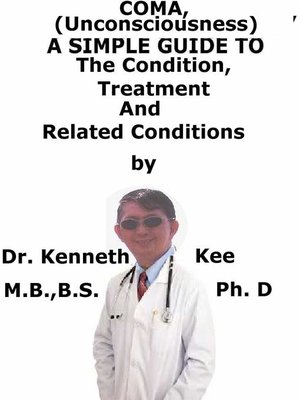Coma, (Unconsciousness) a Simple Guide to the Condition, Treatment and Related Conditions
ebook
By Kenneth Kee

Sign up to save your library
With an OverDrive account, you can save your favorite libraries for at-a-glance information about availability. Find out more about OverDrive accounts.
Find this title in Libby, the library reading app by OverDrive.



Search for a digital library with this title
Title found at these libraries:
| Library Name | Distance |
|---|---|
| Loading... |
A coma is a state of unconsciousness where a person is unresponsive and cannot be woken.
A severe head injury or a condition that affects the brain such as a stroke is two possible causes of a coma.
A person can also be in a coma as a result of alcohol intoxication.
Extreme changes in blood sugar levels in people with diabetes - very low blood glucose levels (hypoglycemia) or very high blood glucose levels (hyperglycemia) - can also cause coma.
You may find the following information useful if you have a friend or a loved one who is in a coma.
Someone who is in a coma has minimal brain activity.
They are alive but cannot move or be woken.
Their potential for recovery will depend on the cause of the coma.
A person in a coma will often be unresponsive to their environment.
They may not be able to hear voices or feel pain.
However, a person in a coma may have some awareness of their surroundings.
Every coma experience is unique.
Occasionally, a person in a coma may open their eyes, grimace or make a noise.
They may not be aware of these movements or have any control over them.
Being in a coma means the person has a low level of consciousness.
Their level of consciousness will depend on how much of their brain is functioning, which may change over time.
For example initially a person may be in a very deep coma where they are unresponsive to pain, before gradually recovering to a lighter coma, where they respond to pain.
They may continue improving and eventually they may become aware of their surroundings and begin to communicate.
The ability to make a clearly conscious response to external instructions indicates that the person is no longer in a coma.
Doctors score a person's level of consciousness using a tool called the Glasgow Coma scale.
The Glasgow Coma Scale assesses three things:
1. Eye opening- a score of one means no eye opening, and four means opens eyes spontaneously
2. Verbal response to a command - a score of one means no response, and five means alert and talking
3. Voluntary movements in response to a command - a score of one means no response, and six means obeys commands
A higher score on the scale suggests that less brain function has been lost.
A score of eight or less is often used to mean that someone is in a relatively deep coma.
Recovery depends on how much of the person's brain has been affected by the underlying condition or injury.
Generally the longer the person has been in a coma, the poorer the outlook.
People don't usually suddenly 'wake up' from a coma, but tend to come round gradually and regain brain function over time.
When a person comes out of a coma, they may be agitated and confused.
They may need to be sedated for their own safety.
Some people will make a full recovery and be completely unaffected by the coma.
TABLE OF CONTENT
Introduction
Chapter 1 Coma
Chapter 2 Interesting Facts about Coma
Chapter 3 Treatment of Coma
Chapter 4 Hypoglycemic Coma
Chapter 5 Induced Coma
Chapter 6 Subarachnoid Hemorrhage
Chapter 7 Cerebral Aneurysm
Chapter 8 Stroke
Epilogue







